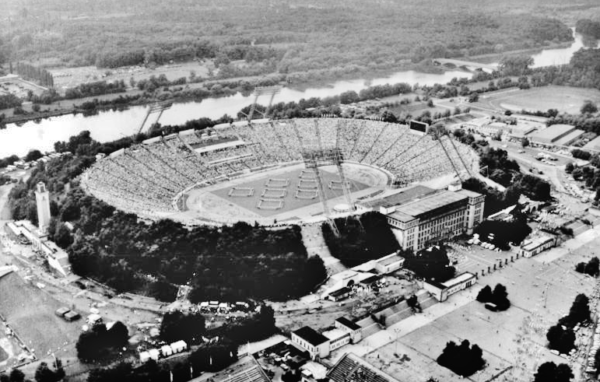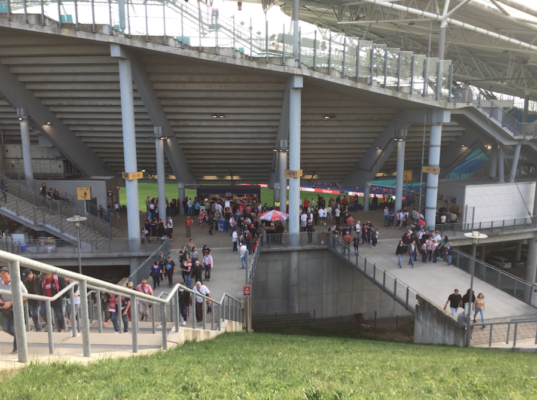Who are RB Leipzig?
For the first time, there will be red bulls in the UEFA Champions League group-stage draw on Thursday but how have Die Roten Bullen found themselves among Europe’s elite?
Leipzig has a legitimate claim of being the home of German football; in 1900 the German Football Association (DFB) was founded in the city and VfB Leipzig won the first national championship in 1903. Yet the city is now home to the most despised football club in the land. RB Leipzig were formed in 2009 after a takeover by energy drink manufacturer Red Bull GmbH of SSV Markrandstadt, a fifth division team based in the Saxony region.
History
For numerous years prior to 2009, Red Bull attempted to purchase several clubs throughout Germany with FC St. Pauli, TSV 1860 Munich and Fortuna Dusseldorf amongst them. However, Red Bull were continually opposed and forced to back down whether it be by the fans of the clubs or the DFB.
Leipzig, however, offered an attractive proposition for investment. No club from the city had played in the Bundesliga since 1994 and there was a hunger to see Leipzig return to the football map. Thus SSV Markranstadt – a small village team situated on the outskirts of Leipzig – epitomised a club that would not offer any opposition to a takeover from a global company and was unconstrained by DFB rules. Hence, a matter of weeks after initial talks began, Markranstadt sold its playing rights and RB Leipzig were formed.
The aim for RasenBallsport Leipzig (Lawn Ball Sports Leipzig) – adopting this title to avoid naming issues whilst still retaining the initials RB – was to reach the Bundesliga within a decade. Having experienced successes with RB Salzburg, RB Brasil and New York Red Bulls the management did not lack ambition.
Four promotions in seven seasons led to their objective becoming reality. The team had strengthened each season and the introduction of Ralf Rangnick as sporting director in 2012 resulted in a focus on developing young European talent and encouraging an attacking dynamic style of play. Rangnick became the manager in 2015 – at the start of their second season in 2.Bundesliga – and signings such as Davie Selke from Werder Bremen, Willi Orban from 1.FC Kaiserslautern and Emil Forsberg from Malmo guided RB Leipzig to their first promotion to the German top flight.
However, Rangnick resigned as manager at the end of the season to focus on his duties as sporting director and Ralph Hassenhuttl – who had guided FC Ingolstadt 04 into the Bundesliga the previous season – became the manager for RB Leipzig’s inaugural Bundesliga season.
RB Leipzig remained undefeated in their first thirteen Bundesliga matches, breaking a record for the longest undefeated run of a promoted team to the Bundesliga and leading them to the top of the table. Leipzig’s form made everyone take note. Their corporate backing and lack of history deterred many from praising this club’s sudden rise but their style and quality of play certainly deserved recognition from even their strongest of adversaries.
RB Leipzig finished the season second only to Bayern and became the first Bundesliga debutant to qualify for European competition since reunification and the first from the old East Germany since FC Union Berlin in 2001.
City
Leipzig, situated about 200 km from Berlin, was once a major urban centre but its economic and cultural importance declined during the Soviet years. Although it played a major part in the fall of communism, it struggled to reintegrate with the rest of Germany. It was seen as a crumbling city with few prospects or hopes at the turn of the millennium.
Nevertheless, Leipzig made a comeback from the grim post-communist period and became the latest German ‘boom town’. It is now considered the ‘creative capital’ of Germany – one of the most liveable cities in Europe. I was in Leipzig in the spring and not only was I impressed with Leipzig’s offering on the pitch – a comfortable 4-0 win against SV Darmstadt– but also the city’s offering off it. The ‘New Berlin’ has experienced a rapid reconstruction into a German powerhouse, an experience shared by their football team.
Stadium
RB Leipzig moved into the Red Bull Arena in 2010 but the stadium also has historical significance. Originally built in 1956, the Zentralstadion was constructed using the debris of the city from World War Two bombings. It was designed by Werner March, the architect behind Berlin’s Olympiastadion, and initially had a capacity of 100,000 – one of the largest in Europe at the time.

It later fell into disrepair before being renovated for the World Cup in 2006. A new stadium was effectively constructed inside the bowl of the original with the use of bridges as gangways. It offers a dramatic aerial view and is certainly one of the more unusual grounds to enter.

Players
Developing youthful European talent has been one of RB’s main aims and in Timo Werner, Marcel Sabitzer and Emil Forsberg they have some of the greatest potential around. Sabitzer, along with one-time Liverpool goalkeeper Peter Gulacsi, moved from sister club RB Salzburg in the summer of 2015. Guinean playmaking midfielder Naby Keita followed in their footsteps twelve months later and has rapidly become Leipzig’s leading light – catching the attention of a number of Europe’s elite clubs.
Leipzig are a multinational team with Hungary, Norway, Sweden and Scotland all regularly represented but there still remains a German core with Orban, Kaiser and Werner all consistent starters. Werner, in particular, has impressed over the past twelve months scoring twenty-one goals in the league last season and playing an integral part in Germany’s success in the FIFA Confederations Cup during the summer.
Manager
Considering RB Leipzig have only been in existence for seven years, it is quite surprising that they have already had seven managers. The current manager, Austrian Ralph Hasenhuttl, has himself rose through the ranks of German football having had successful spells with VfR Aalen and FC Ingolstadt 04. Winning Bundesliga promotion with Ingolstadt and achieving a mid-table finish in their debut season led to RB giving him the opportunity to take over in Saxony.
Hasenhuttl’s stock has risen further after his achievements with RB Leipzig last season and has even been suggested as a potential successor to Carlo Ancelotti at FC Bayern Munich or possibly joining a club in the Premier League. However, the partnership of Hasenhuttl and Rangnick is a clear exemplification of how a sporting director structure can work efficiently and successfully.
In the space of less than a decade, RB Leipzig have become a serious threat to the German old guard. A charmed, trophy-laden run through the lower divisions, an attractive attacking style, a recruitment policy that promotes youth and boisterous home support in an area starved of success appears like all the ingredients for a football fairytale. Although not everyone buys this sentiment, the red bulls are raging and Europe is next.
